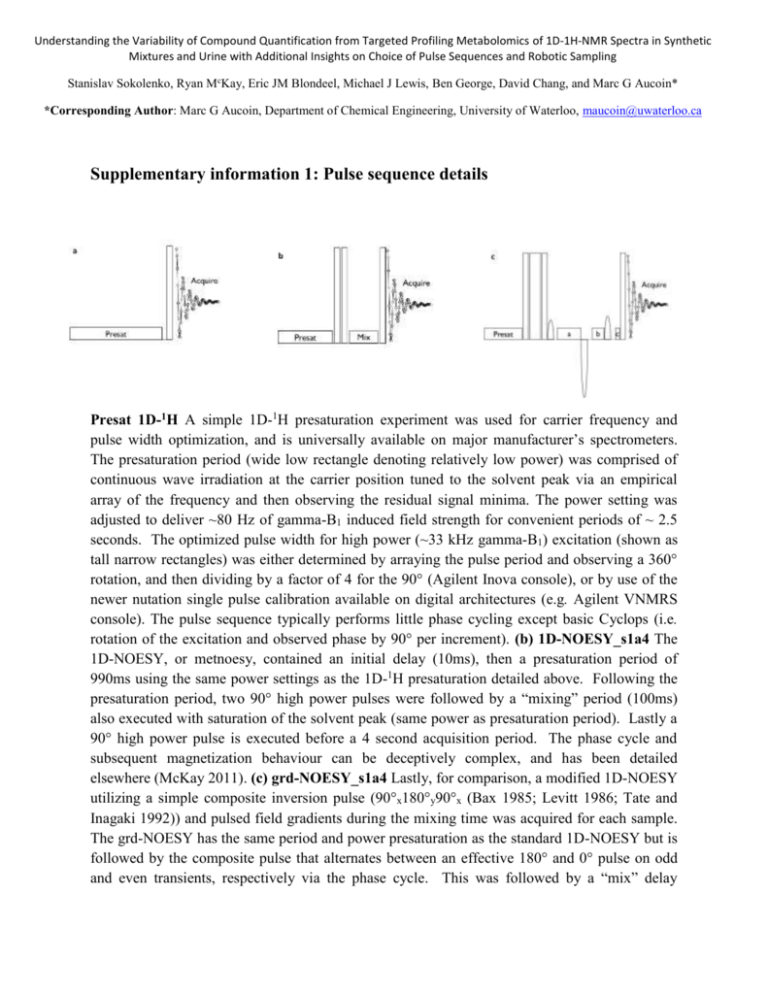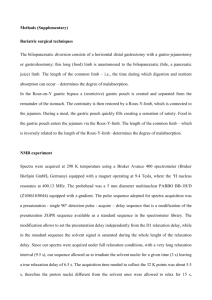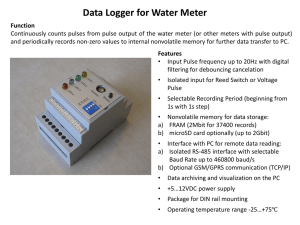Supplementary information 1: Pulse sequence details
advertisement

Understanding the Variability of Compound Quantification from Targeted Profiling Metabolomics of 1D-1H-NMR Spectra in Synthetic Mixtures and Urine with Additional Insights on Choice of Pulse Sequences and Robotic Sampling Stanislav Sokolenko, Ryan McKay, Eric JM Blondeel, Michael J Lewis, Ben George, David Chang, and Marc G Aucoin* *Corresponding Author: Marc G Aucoin, Department of Chemical Engineering, University of Waterloo, maucoin@uwaterloo.ca Supplementary information 1: Pulse sequence details Presat 1D-1H A simple 1D-1H presaturation experiment was used for carrier frequency and pulse width optimization, and is universally available on major manufacturer’s spectrometers. The presaturation period (wide low rectangle denoting relatively low power) was comprised of continuous wave irradiation at the carrier position tuned to the solvent peak via an empirical array of the frequency and then observing the residual signal minima. The power setting was adjusted to deliver ~80 Hz of gamma-B1 induced field strength for convenient periods of ~ 2.5 seconds. The optimized pulse width for high power (~33 kHz gamma-B1) excitation (shown as tall narrow rectangles) was either determined by arraying the pulse period and observing a 360° rotation, and then dividing by a factor of 4 for the 90° (Agilent Inova console), or by use of the newer nutation single pulse calibration available on digital architectures (e.g. Agilent VNMRS console). The pulse sequence typically performs little phase cycling except basic Cyclops (i.e. rotation of the excitation and observed phase by 90° per increment). (b) 1D-NOESY_s1a4 The 1D-NOESY, or metnoesy, contained an initial delay (10ms), then a presaturation period of 990ms using the same power settings as the 1D-1H presaturation detailed above. Following the presaturation period, two 90° high power pulses were followed by a “mixing” period (100ms) also executed with saturation of the solvent peak (same power as presaturation period). Lastly a 90° high power pulse is executed before a 4 second acquisition period. The phase cycle and subsequent magnetization behaviour can be deceptively complex, and has been detailed elsewhere (McKay 2011). (c) grd-NOESY_s1a4 Lastly, for comparison, a modified 1D-NOESY utilizing a simple composite inversion pulse (90°x180°y90°x (Bax 1985; Levitt 1986; Tate and Inagaki 1992)) and pulsed field gradients during the mixing time was acquired for each sample. The grd-NOESY has the same period and power presaturation as the standard 1D-NOESY but is followed by the composite pulse that alternates between an effective 180° and 0° pulse on odd and even transients, respectively via the phase cycle. This was followed by a “mix” delay totalling 100ms in length, split into three solvent saturation of 59, 29, and 9ms each. These sections were separated by pulse field gradients (Keeler et al. 1994) of 1ms duration and amplitudes of 3.75, -18.75, and 5.625 gauss/cm (i.e. 2:-10:3) respectively. Lastly a 90° pulse perturbed bulk magnetization into the transverse plane for the 4 second acquisition period. The sweep width used on all experiments (600 MHz instrument) was 7225.4 Hz, with 4 steady states before collection of 32 transients. Data were zero filled to twice the number of acquired points, and an apodization window of 0.5 Hz line broadening was applied before fast fourier transformation and analysis with Chenomx Suite software. The authors would like to acknowledge that the grd-NOESY_s1a4 used in this study was first presented as a poster by RM et al. (2009) at the Experimental Nuclear Magnetic Resonance Conference in Pacific Grove, California and co-developed with Leo Spyracopoulos of the Department of Biochemistry, University of Alberta. References Bax A (1985) A spatially selective composite 90° radiofrequency pulse. Journal of Magnetic Resonance 65:142–145. Keeler J, Clowes RT, Davis AL, Laue ED (1994) Pulsed-field gradients: Theory and practice. Methods in Enzymology 239:145–207. doi: 10.1016/S0076-6879(94)39006-1 Levitt MH (1986) Composite pulses. Progress in NMR Spectroscopy 18:61–122. McKay RT (2011) How the 1D-NOESY suppresses solvent signal in metabonomics NMR spectroscopy: An examination of the pulse sequence components and evolution. Concepts in Magnetic Resonance Part A 38A:197–220. doi: 10.1002/cmr.a Tate S, Inagaki F (1992) Reduction of the water hump using a composite refocusing pulse. Journal of Magnetic Resonance 96:635–643.








